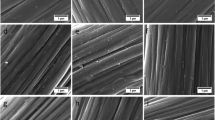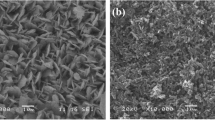Abstract
Polyaniline was electrosynthesized using three voltammetric cycles on carbon fiber felts annealed at 1400, 1600, 2000, and 2300 K. Felts and composites was characterized by scanning electron microscopy, X-ray diffraction, Raman and Fourier transform infrared spectroscopy, and electrochemical impedance spectroscopy. Annealing temperatures increasing provides more crystalline felts. The increase of capacitance is due to presence of functional groups that attract a lot of charge to double layer. Capacitance found for felts treated in 1400 K is larger compared to felts treated in 2300 K. The functional groups presence on annealed felts at lower temperature implies polyaniline growth in several orientations and regions, evidenced by the high heteroatoms ratios which decrease with increasing annealing temperature. Therefore, for higher temperatures, the polyaniline growth occurs at several additional orientations. The polyaniline oxidation degree was close to emeraldine allowing mobile charge presence. Electrochemical impedance spectroscopy confirmed that as temperature decreases, resistance of inner and outer double layer decreases. To 1600 K annealing, polyaniline showed an increase in inner double layer capacitance which can be confirmed by lower ratio between bipolarons and polarons. The tendency to increase energy and power density is most prominent for polyaniline at 2300 K felt.
















Similar content being viewed by others
References
Ran F, Tan Y, Dong W, Liu Z, Kong L, Kang L (2018) In situ polymerization and reduction to fabricate gold nanoparticle incorporated polyaniline as supercapacitor electrode materials. Polym Adv Technol 29(6):1697–1705
Sato K, Noguchi M, Oki N, Oyama S (1999) Active carbon used for electrode for organic solvent type electric double layer capacitor. United States Patent
Winter M, Brodd RJ (2004) What are batteries, fuel cells, and supercapacitors. Chem Rev 104(10):4245–4269
Mondal S, Rana U, Malik S (2015) Graphene quantum dot-doped polyaniline nanofiber as high performance supercapacitor electrode materials. Chem Commun 51(62):12365–12368
Mitchell E, Candlera J, Souza F, Gupta RK, Gupba BK, Dongc LF (2015) High performance supercapacitor based on multilayer of polyaniline and graphene oxide. Synth Met 199:214–218
Almeida DAL, Carvalho AAR Jr, Fonseca CP, Baldan MR, Ferreira NG (2013) Electrochemical performance of supercapacitors formed by PAni/CF and PAni/CNT/CF. ECS Trans 58:35–41
Souza LL (2011) Uso da Voltametria Cíclica e da Espectroscopia de Impedância Eletroquímica na Determinacão da Área superficial ativa de Eletrodos Modificados a Base de Carbono (Thesis).Instituto de Pesquisas Energeticas e Nucleares Associada à Universidade de Sao Paulo, Sao Paulo
Nooshabadiand MS, Zahedi F (2017) Electrochemical reduced graphene oxide-polyaniline as effective nanocomposite film for high-performance supercapacitor applications. Electrochim Acta 245:575–586
Male U, Modigunta JKR, Huh DS (2016) Design and synthesis of polyaniline-grafted reduced graphene oxide via azobenzene pendants for high-performance supercapacitors. Polymer 110:242–249
Huang H, Gan M, Ma L, Yu L, Hu H, Yang F, Li Y, Ge C (2015) Fabrication of polyaniline/graphene/titania nanotube arrays nanocomposite and their application in supercapacitors. J Alloys Compound 630:214–221
Poli AKSP, Caetano GMD, Vargas LR, Gama AM, Baldan MR, Gonçalves ES (2017) Electrosynthesis of polyaniline on carbon fiber felt: influence of voltammetric cycles on electroactivity. J Electrochem Soc 164:631–639
Focke WW, Wnek GE (1988) Conduction mechanisms in polyaniline (emeraldine salt). J Electroanal Chem 256(2):343–352
Kanemoto H, Kawamura T, Suzuki H, Miyazaki T, Mozumi H, Kaneko Y (2017) Electroless copper plating process by applying alternating one-side air stirring method for high-aspect-ratio through-holes. J Electrochem Soc 164:771–777
Prasanna C (1999) Conducting polymers, fundamentals and applications: a practical approach. Springer Science & Business Media
Nohara LB, Filho GP, Nohara EL, Kleinke MU, Rezende MC (2005) Evaluation of carbon fiber surface treated by chemical and cold plasma processes. Mater Res 8(3):281–286
Pittman CU, He GR, Wu B, Gardner SD (1997) Chemical modification of carbon fiber surfaces by nitric acid oxidation followed by reaction with tetraethylenepentamine. Carbon 35(3):317–331
Gonçalves ES, Dalmolin C, Biaggio SR, Nascente PAP, Rezende MC, Ferreira NG (2007) Influence of heat treatment temperature on the morphological and structural aspects of reticulated vitreous carbon used in polyanilineelectrosynthesis. Appl Surf Sci 253:8340–8344
Kim JD, Roh JS, Kim MS (2017) Effect of carbonization temperature on crystalline structure and properties of isotropic pitch-based carbon fiber. Carbon Lett 21:51–60
Gonçalves ES, Rezende MC, Baldan MR, Ferreira NG (2009) Efeito do tratamentotérmiconamicroestrutura, turbostraticidade e superfície de carbon vítreo reticulado analisado por XPS, espalhamento Raman e voltametria cíclica. Quím Nova 32(1):158–164
Gonçalves ES, Rezende MC, Ferreira NG (2006) Dynamics of defects and surface structure formation in reticulated vitreous carbon. Braz J Phys 36(2a):264–266
Lee S, Kim KH, Lee Y (2017) Preparation of carbon discs using petroleum-based binder pitch reformed with carbon black. Carbon Lett 23:84–87
He M, Zheng Y, Du Q (2013) Electrochemical fabrication of polyaniline/MnO2 graphite felt as free standing, flexible electrode for supercapacitors. Polym Compos 34(6):819–824
Wangxi Z, Jie L, Gang W (2003) Evolution of structure and properties of PAN precursors during their conversion to carbon fibers. Carbon 41(14):2805–2812
Fu Z, Liu B, Sun L, Zhang H (2017) Study on the thermal oxidative stabilization reactions and the formed structures in polyacrylonitrile during thermal treatment. Polym Degrad Stab 140:104–113
Smith AL (1979) Applied infrared spectroscopy: fundamentals, techniques and analytical problem-solving. Wiley
Stuart B (2005) Infrared spectroscopy: fundamentals and applications. Vol 1, Analytical Techniques in the Sciences
Casiraghi C, Hartschuh A, Qian H, Piscanec S, Georgi C, Fasoli A, Novoselov KS, Basko DM, Ferrari AC (2009) Raman spectroscopy of graphene edges. Nano Lett 9(4):1433–1441
Cuesta A, Dhamelincourt P, Laureyns J, Martínez-Alonsoand A, Tascon JMD (1994) Raman microprobe studies on carbon materials. Carbon 32(8):1523–1532
Sadezky A, Muckenhuber H, Grothe H, Niessner R, Pöschl U (2005) Raman microspectroscopy of soot and related carbonaceous materials: spectral analysis and structural information. Carbon 43(8):1731–1742
Jawhari T, Roid A, Casado J (1995) Raman spectroscopic characterization of some commercially available carbon black materials. Carbon 33(11):1561–1565
Junior MAA, Matsushima JT, Rezende MC, Gonçalves ES, Marcuzzo JS, Baldan MR (2017) Production and characterization of activated carbon fiber from textile PAN fiber. J Aerosp Technol Manag 9(4):423–430
Almeida DAL (2013) Estudo de Compósito de Nanotubos de Carbono, Fibras de Carbono e Polianilina como Eletrodos em Dispositivos de Conversão e Armazenamento de Energia. (Thesis) Instituto Nacional de Pesquisas Espaciais, São José dos Campos
Almeida EC, Trava-Airoldi V, Ferreira NG, Rosolen JM (2005) Electrochemical insertion of lithium into a doped diamond film grown on carbon felt substrate. Diam Relat Mat 14(10):1673–1677
Cançado LG, Takai K, Enoki T, Endo M, Kim Y, Mizusaki H, Jorio A, Coelho L, Paniago R, Pimenta M (2006) General equation for the determination of the crystallite size L a of nanographite by Raman spectroscopy. Appl Phys Lett 88(16):163106
Boukamp BA (1986) A nonlinear least squares fit procedure for analysis of immittance data of electrochemical systems. Solid State Ionics 20(1):31–44
Boukamp BA (1986) A package for impedance/admittance data analysis. Solid State Ionics 18-19:136–140
Boukamp BA (2004) Electrochemical impedance spectroscopy in solid state ionics: recent advances. Solid State Ionics 169(1-4):65–73
Bisquert J, Garcia-Belmonte G, Fabregat-Santiago F, Ferriols NS, Yamashita M, Pereira EC (2000) Application of a distributed impedance model in the analysis of conducting polymer films. Electrochem Commun 2(8):601–605
Garcia-Belmonte G, Bisquert J, Pereira EC, Fabregat-Santiago F (2001) Switching behaviour in lightly doped polymeric porous film electrodes. Improving distributed impedance models for mixed conduction conditions. J Electroanal Chem 508(1-2):48–58
Rodrigues AC (2018) Estudo e caracterização de fibras de carbon ativadas com adsorção de prata e ferroparaaplicaçãoemsupercapacitor (Thesis), Instituto Tecnológico de Aeronáutica, São José dos Campos
Hopkins AR, Lipeles RA, Hwang SJ (2008) Morphology characterization of polyaniline nano- and microstructures. Synth Met 158(14):594–601
Oliveira LR, Manzato L, Mascarenhas YP, Sanches EA (2017) The influence of heat-treatment on the semi-crystalline structure of polyaniline emeraldine-salt form. J Mol Struct 1128:707–717
Mazzeu MAC, Faria LK, Cardoso AM, Gama AM, Baldan MR, Gonçalves ES (2017) Structural and morphological characteristics of polyaniline synthesized in pilot scale. J Aerosp Technol Manag 9(1):39–47
Jenkins GM, Kawamura K (1976) Polymeric carbons: carbon fiber, glass and char. Cambridge University Press, Cambridge
Mattos EC, Vigano I, Dutra RCL, Diniz MF (2002) Aplicação de metodologias FT-IR de transmissao e fotoacústica a caracterização de materiais altamente energéticos: parte II. Quim Nova 25(5):722–728
Zeng XR, KoTM (1998) Structures and properties of chemically reduced polyanilines. Polymer 39(5):1187–1195
Dmitrieva E, Dunsch L (2011) How linear is “linear” polyaniline? J Phys Chem B 115(20):6401–6411
Shabani-Nooshabadi M, Zahedi F (2017) Electrochemical reduced grapheme oxide-polyaniline as effective nanocomposite film for high-performance supercapacitor applications. Electrochim Acta 246:575–586
Tang J, Jing X, Wang B, Wang F (1988) Infrared spectra of soluble polyaniline. Synth Met 24(3):231–238
Wang H, Yang X, Hao Q, Lu L, Wang X (2009) Graphene oxide doped polyaniline for supercapacitors. Electrochem Commun 11(6):1158–1161
Colomban P, Gruger A, Novak A, Regis A (1994) Infrared and Raman study of polyaniline: part I. hydrogen bonding and electronic mobility in emeraldine salts. J Mol Struct 317(3):261–271
Cochet M, Louarn G, Quillard S, Boyer MI, Buisson JP, Lefrant S (2000) Theoretical and experimental vibrational study of polyaniline in base forms: non-planar analysis. Part I. J Raman Spectrosc 31(11):1029–1039
Du F, Wang J, Tang C, Tsui C, Xie X, Yung K (2013) Enhanced electrochemical capacitance of polyaniline/graphene hybrid nanosheet with graphene as templates. Compos Part B 53:376–381
Morávková Z, Dmitrieva E (2017) Structural change in polyaniline near the middle oxidation peak studied by in situ Raman spectroelectrochemistry. J Raman Spectrosc 48(9):1229–1234
Bernards MC, Goff AH (2006) Quantitative characterization of polyaniline films using Raman spectroscopy. I: polaron lattice and bipolaron. Electrochim Acta 52(2):595–603
Bredas JL, Street GB (1985) Polarons, bipolarons, and solitons in conducting polymers. Acc Chem Res 18(10):309–315
Anderson PW (1975) Model for the electronic structure of amorphous semiconductors. Phys Rev Lett 34(15):953–955
Macdonald JR, Schoonman J, Lehnen AP (1982) Applicability and power of complex nonlinear least squares for the analysis of impedance and admittance data. J Electroanal Chem 131:77–95
Acknowledgements
The authors would like to thank for technician support or AMR/IAE, AQI/IAE, and LAS/INPE.
Funding
The authors are grateful for the financial support of FAPESP (project 2016/11462-3). This study was financed in part by the Coordenação de Aperfeiçoamento de Pessoal de Nível Superior – Brasil (CAPES) - Finance Code 001.
Author information
Authors and Affiliations
Corresponding author
Rights and permissions
About this article
Cite this article
dos Santos Poli, A.K., Hilário, R.B., Gama, A.M. et al. Influence of heat treatment temperature of carbon fiber felt substrate on polyaniline electrosynthesis and its properties. J Solid State Electrochem 23, 33–52 (2019). https://doi.org/10.1007/s10008-018-4107-8
Received:
Revised:
Accepted:
Published:
Issue Date:
DOI: https://doi.org/10.1007/s10008-018-4107-8




